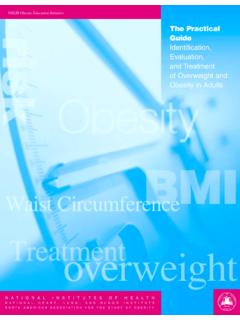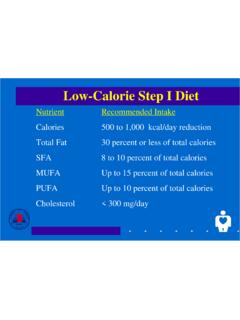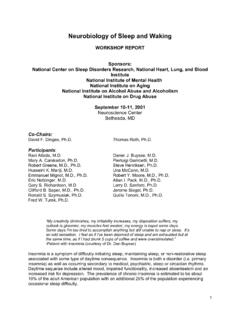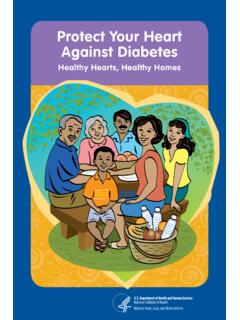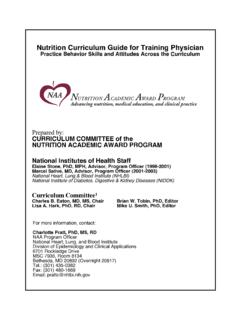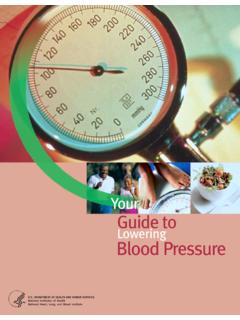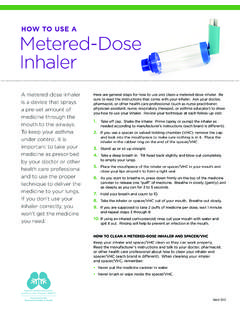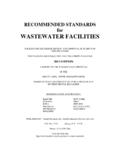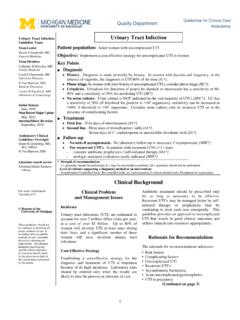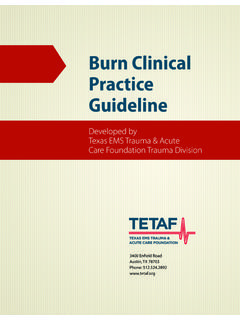Transcription of Asthma Care Quick Reference
1 guidelines from the National Asthma Education and Prevention Program The goal of this Asthma care Quick Reference guide is to help clinicians provide quality care to people who have Asthma care involves not only initial diagnosis and treatment to achieve Asthma control, but also long-term, regular follow-up care to maintain control. Asthma control focuses on two domains: (1) reducing impairment the frequency and intensity of symptoms and functional limitations currently or recently experienced by a patient; and (2) reducing risk the likelihood of future Asthma attacks, progressive decline in lung function (or, for children, reduced lung growth), or medication side effects. Achieving and maintaining Asthma control requires providing appropriate medication, addressing environmental factors that cause worsening symptoms, helping patients learn self-management skills, and monitoring over the long term to assess control and adjust therapy accordingly.
2 The diagram (right) illustrates the steps involved in providing quality Asthma VISITD iagnose asthmaSchedule follow-up appointmentDevelop written Asthma action planInitiate medication & demonstrate useAssess Asthma severityAssess & monitor Asthma controlSchedule next follow-up appointmentReview Asthma action plan, revise as neededMaintain, step up, or step down medicationReview medication technique & adherence; assess side effects; review environmental controlFOLLOW-UP VISITSEXPERT PANEL REPORT 3 This guide summarizes recommendations developed by the National Asthma Education and Prevention Program s expert panel after conducting a systematic review of the scientific literature on Asthma care. See for the full report and references. Medications and dosages were updated in September 2011 for the purposes of this Quick Reference guide to reflect currently available Asthma Care Quick ReferenceDIAGNOSING AND MANAGING ASTHMAKEY CLINICAL ACTIVITIES FOR QUALITY Asthma CARE(See complete table in Expert Panel Report 3: guidelines for the Diagnosis and Management of Asthma [EPR-3])Clinical IssueKey Clinical Activities and Action Steps Asthma DIAGNOSISE stablish Asthma diagnosis.
3 Determine that symptoms of recurrent airway obstruction are present, based on history and exam. History of cough, recurrent wheezing, recurrent difficulty breathing, recurrent chest tightness Symptoms occur or worsen at night or with exercise, viral infection, exposure to allergens and irritants, changes in weather, hard laughing or crying, stress, or other factors In all patients 5 years of age, use spirometry to determine that airway obstruction is at least partially reversible. Consider other causes of obstruction. LONG-TERM Asthma MANAGEMENTGOAL: Asthma ControlReduce Impairment Prevent chronic symptoms. Require infrequent use of short-acting beta2-agonist (SABA). Maintain (near) normal lung function and normal activity Risk Prevent exacerbations. Minimize need for emergency care, hospitalization. Prevent loss of lung function (or, for children, prevent reduced lung growth). Minimize adverse effects of and MonitoringINITIAL VISIT: Assess Asthma severity to initiate treatment (see page 5).
4 FOLLOW-UP VISITS: Assess Asthma control to determine if therapy should be adjusted (see page 6). Assess at each visit: Asthma control, proper medication technique, written Asthma action plan, patient adherence, patient concerns. Obtain lung function measures by spirometry at least every 1 2 years; more frequently for Asthma that is not well controlled. Determine if therapy should be adjusted: Maintain treatment ; step up, if needed; step down, if follow-up care. Asthma is highly variable over time. See patients: Every 2 6 weeks while gaining control Every 1 6 months to monitor control Every 3 months if step down in therapy is anticipatedUse of MedicationsSelect medication and delivery devices that meet patient s needs and circumstances. Use stepwise approach to identify appropriate treatment options (see page 7). Inhaled corticosteroids (ICSs) are the most effective long-term control therapy. When choosing treatment , consider domain of relevance to the patient (risk, impairment, or both), patient s history of response to the medication, and willingness and ability to use the medication.
5 Review medications, technique, and adherence at each follow-up Asthma Care Quick ReferenceKEY CLINICAL ACTIVITIES FOR QUALITY Asthma CARE (continued)Clinical IssueKey Clinical Activities and Action StepsPatient Education for Self-ManagementTeach patients how to manage their Asthma . Teach and reinforce at each visit: Self-monitoring to assess level of Asthma control and recognize signs of worsening Asthma (either symptom or peak flow monitoring) Taking medication correctly (inhaler technique, use of devices, understanding difference between long-term control and Quick -relief medications)- Long-term control medications (such as inhaled corticosteroids, which reduce inflammation) prevent symptoms. Should be taken daily; will not give Quick Quick -relief medications (short-acting beta2-agonists or SABAs) relax airway muscles to provide fast relief of symptoms. Will not provide long-term Asthma control.
6 If used >2 days/week (except as needed for exercise-induced Asthma ), the patient may need to start or increase long-term control medications. Avoiding environmental factors that worsen asthmaDevelop a written Asthma action plan in partnership with patient/family (sample plan available at ). Agree on treatment goals. Teach patients how to use the Asthma action plan to: Take daily actions to control Asthma Adjust medications in response to worsening Asthma Seek medical care as appropriate Encourage adherence to the Asthma action plan. Choose treatment that achieves outcomes and addresses preferences important to the patient/family. Review at each visit any success in achieving control, any concerns about treatment , any difficulties following the plan, and any possible actions to improve adherence. Provide encouragement and praise, which builds patient confidence. Encourage family involvement to provide education into all points of care involving interactions with patients.
7 Include members of all health care disciplines ( , physicians, pharmacists, nurses, respiratory therapists, and Asthma educators) in providing and reinforcing education at all points of of Environmental Factors and Comorbid ConditionsRecommend ways to control exposures to allergens, irritants, and pollutants that make Asthma worse. Determine exposures, history of symptoms after exposures, and sensitivities. (In patients with persistent Asthma , use skin or in vitro testing to assess sensitivity to perennial indoor allergens to which the patient is exposed.) Recommend multifaceted approaches to control exposures to which the patient is sensitive; single steps alone are generally ineffective. Advise all Asthma patients and all pregnant women to avoid exposure to tobacco smoke. Consider allergen immunotherapy by trained personnel for patients with persistent Asthma when there is a clear connection between symptoms and exposure to an allergen to which the patient is sensitive.
8 Treat comorbid conditions. Consider allergic bronchopulmonary aspergillosis, gastroesophageal reflux, obesity, obstructive sleep apnea, rhinitis and sinusitis, and stress or depression. treatment of these conditions may improve Asthma control. Consider inactivated flu vaccine for all patients >6 months of Care Quick Reference Asthma CARE FOR SPECIAL CIRCUMSTANCES Clinical IssueKey Clinical Activities and Action StepsExercise-Induced Bronchospasm Prevent EIB.* Physical activity should be encouraged. For most patients, EIB should not limit participation in any activity they choose. Teach patients to take treatment before exercise. SABAs* will prevent EIB in most patients; LTRAs,* cromolyn, or LABAs* also are protective. Frequent or chronic use of LABA to prevent EIB is discouraged, as it may disguise poorly controlled persistent Asthma . Consider long-term control medication. EIB often is a marker of inadequate Asthma control and responds well to regular anti-inflammatory therapy.
9 Encourage a warm-up period or mask or scarf over the mouth for cold-induced Asthma control through pregnancy. Check Asthma control at all prenatal visits. Asthma can worsen or improve during pregnancy; adjust medications as needed. Treating Asthma with medications is safer for the mother and fetus than having poorly controlled Asthma . Maintaining lung function is important to ensure oxygen supply to the fetus. ICSs* are the preferred long-term control medication. Remind patients to avoid exposure to tobacco EXACERBATIONSC linical IssueKey Clinical Activities and Action StepsHome CareDevelop a written Asthma action plan (see Patient Education for Self-Management, page 3).Teach patients how to: Recognize early signs, symptoms, and PEF* measures that indicate worsening Asthma . Adjust medications (increase SABA* and, in some cases, add oral systemic corticosteroids) and remove or withdraw from environmental factors contributing to the exacerbation.
10 Monitor response. Seek medical care if there is serious deterioration or lack of response to treatment . Give specific instructions on who and when to or Emergency Care Assess severity by lung function measures (for ages 5 years), physical examination, and signs and to relieve hypoxemia and airflow obstruction; reduce airway inflammation. Use supplemental oxygen as appropriate to correct hypoxemia. Treat with repetitive or continuous SABA,* with the addition of inhaled ipratropium bromide in severe exacerbations. Give oral systemic corticosteroids in moderate or severe exacerbations or for patients who fail to respond promptly and completely to SABA. Consider adjunctive treatments, such as intravenous magnesium sulfate or heliox, in severe exacerbations unresponsive to response with repeat assessment of lung function measures, physical examination, and signs and symptoms, and, in emergency department, pulse with medication and patient education: Medications: SABA, oral systemic corticosteroids; consider starting ICS* Referral to follow-up care Asthma discharge plan Review of inhaler technique and, whenever possible, environmental control measures*Abbreviations: EIB, exercise-induced bronchospasm; ICS, inhaled corticosteroid; LABA, long-acting beta2-agonist; LTRA, leukotriene receptor antagonist; PEF, peak expiratory flow.
